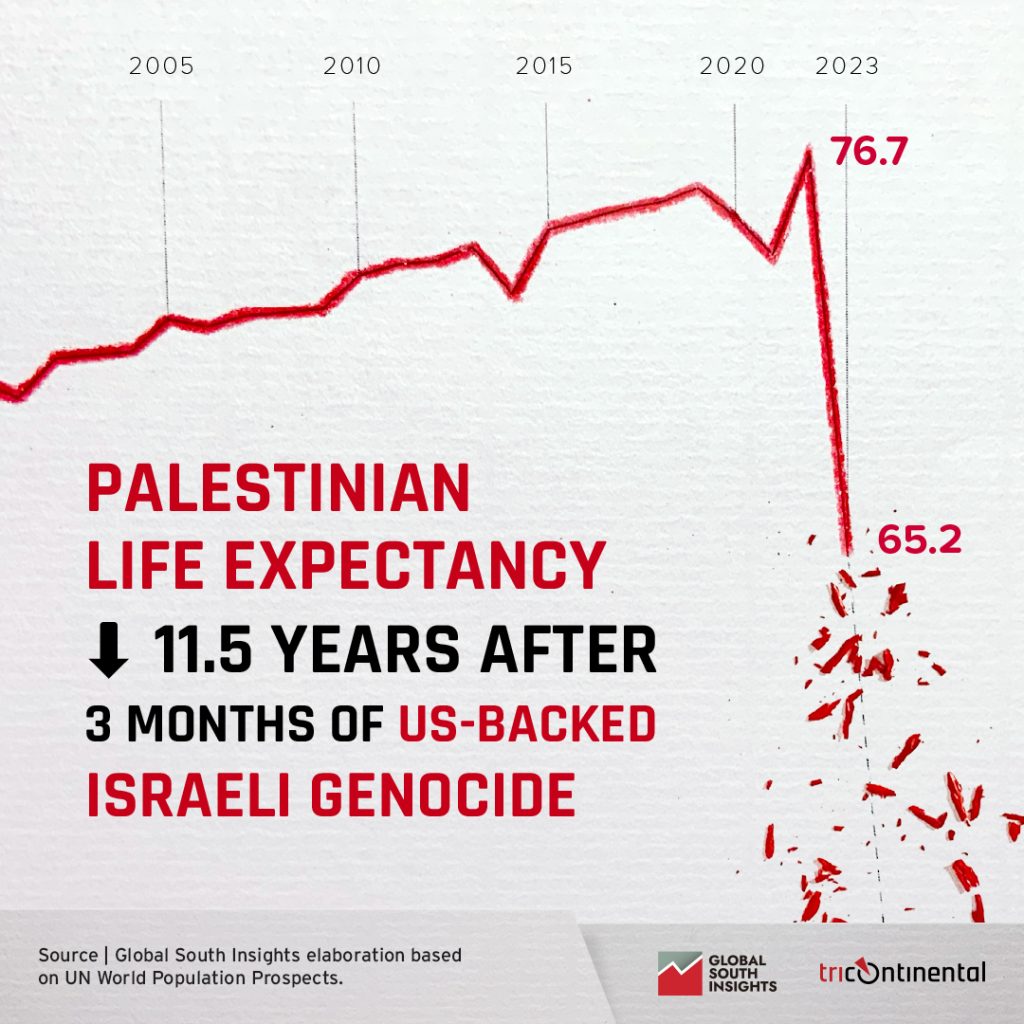THE TRICONTINENTAL

The US-backed genocide in Gaza has led to a precipitous loss in the population’s life expectancy. Even as the ceasefire allows aid to enter Gaza, this profound demographic loss will take generations to revert.
Dear friends,
Greetings from the desk of Tricontinental: Institute for Social Research.
The idea of a ceasefire is as old as the idea of war. In old records, one reads of halts in firing for humans to eat or sleep. Rules of combat developed out of an understanding that both sides had to rest or refresh themselves. Sometimes, this understanding included the lives of animals. During the Easter Rising in 1916, for instance, the Irish rebels and the British troops stopped their shooting around St. Stephen’s Green in Dublin so that James Kearney, the park keeper, could enter and feed the ducks. It was this caesura, or pause, of gunfire that popularised the term ‘ceasefire’.
For Palestinians in Gaza, any ceasefire that promises to stop the bombardment and allow for the arrival of humanitarian aid (particularly food, water, medicine, and blankets) is a relief. In the days since 19 January, when a temporary ceasefire went into effect, aid at scale has been able to reach Gazans, United Nations Office for the Coordination of Humanitarian Affairs spokesperson Jens Laerke confirmed. On the first day of the ceasefire, 630 trucks entered Gaza – many more than the fifty to one hundred trucks per day that struggled to get in during the Israeli bombing. These trucks are ‘getting food in, opening bakeries, getting healthcare, restocking hospitals, repairing water networks, repairing shelter, family reunifications’, and carrying out other essential work, Laerke said. After almost five hundred days of genocidal violence, this aid is more than a relief. It is a lifeline. But this ceasefire agreement had first been tabled in May 2024, when it was approved by the Israeli government and later agreed to by Hamas until ultimately being rejected by Netanyahu. The guns could have been silenced then.

Palestine has been deeply impacted by the genocide. Using estimates from the United Nations’ World Population Prospects 2024, Tricontinental: Institute for Social Research and Global South Insights analysed the decline in Palestinian life expectancy caused by the Israeli bombardment in Gaza and found that Palestinian life expectancy at birth fell by 11.5 years between 2022 and 2023, from a respectable 76.7 years in 2022 to just 65.2 years in 2023. It was the first three months of the US-backed Israeli bombing – from October to December 2023 – that brought about this terrible decline in total life expectancy. We are not aware of such a rapid decline in life expectancy at any other period of modern human history. A Palestinian life is now more than seventeen years shorter than an Israeli one. This gap is greater than that which existed between blacks and whites in apartheid South Africa, which was fifteen years in 1980.
Eleven and a half years lost per Palestinian. That is almost 60 million years lost for the remaining 5.2 million Palestinians who have remained in Palestine and survived the genocide. This loss cannot easily be recovered. It will take years of immense work to rebuild Palestinian society and reach anything near the pre-genocide life expectancy. Health systems will need to be rebuilt: not only hospitals and clinics, which were almost all destroyed in Gaza, but new doctors and nurses will have to be trained to replace those who were killed. Food systems will need to be recovered: not only bakeries, but fields will need to be detoxified and fishing boats repaired. Housing will need to be rebuilt to replace the 92% of homes in Gaza that were destroyed or damaged (what the UN has called a ‘domicide’). Schools will need to be rebuilt. The mental trauma that afflicts children will need to be healed so that they feel that these structures are not graves but places of safety and learning.
The Tricontinental for more
